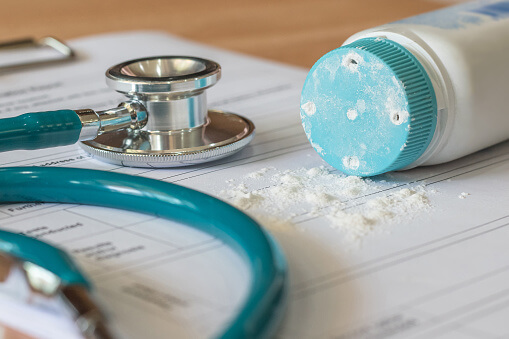A California state court judge recently declared a mistrial in a Johnson & Johnson (J&J) baby powder case. This ruling came once jurors informed Judge Margaret Oldendorf they were deadlocked. This ruling came as a result after the trial went on for five days and swapped out two substitute jurors. The case listed Imerys, J&J’s talc supplier, as a co-defendant as well, but that company struck a confidential settlement and exited the case.
Plaintiff Carolyn Weirick filed the suit seeking compensation for her mesothelioma. She claims her disease is a result of years of inhaling asbestos fibers in Johnson’s baby powder. J&J stated at the trial that their talc products do not contain asbestos. But evidence presented at the trial suggests otherwise.
Mistrial Called Despite Asbestos Fibers Proof in J&J Bottle
Weirick’s attorneys called expert witness Dr. William Longo to testify in the courtroom. Longo is a materials scientist and electron microscope researcher. His specialty is in asbestos identification for the MAS lab in Suwanee, Georgia. When Weirick’s lawyers asked if he found any evidence of asbestos in her J&J baby powder bottle, he said yes.
“We found what I would call the anthophyllite (a form of asbestos) series with fibers and bundles in a 14.8-1 ratio.”
Visuals to match his testimony clearly showed 24,700 fibers were identified in her J&J product.
Longo then explained that asbestos can appear as a single fiber, or in bundles. He states that asbestos should be five times longer than they are wide under a microscope. Despite this evidence, the jury couldn’t agree on a ruling. This resulted in a mistrial for Weirick’s baby powder case.
Asbestos Evidence and J&J Talcum Powder Products
Thousands of women just like Carolyn Weirick are suing J&J for failing to warn consumers about the dangers of their products. Clinical studies and research papers dating back as far as 1971, linking their talc with asbestos. Longo’s study and expert witness are just one more piece of evidence condemning J&J for their actions. New evidence against J&J is presented at nearly every trial. This particular evidence is important because it shows that there are, in fact, cancer-causing agents in J&J products.
Despite microscopic evidence, however, J&J continues to refute the claim that their products have asbestos. After the mistrial, J&J spokeswoman Kim Montagnino told CVN that J&J would seek a retrial. “We look forward to a new trial to present our defense – which rests on decades of independent, scientific testing confirming that J&J Baby Powder and Shower to Shower do not contain asbestos.” She then states that J&J talc products have been safely used for more than 130 years.
File Your Own Talcum Powder Case
The majority of talcum powder cases rest in the talcum powder MDL, formed in 2017. Plaintiffs allege that perineal use of baby powder led to their ovarian cancer. Others allege that inhaling the asbestos-laden powder led to mesothelioma. Joining the MDL is easy with the right attorney.
If you developed ovarian cancer after long-term regular talc use, you may qualify for compensation. Fill out your free talcum powder claim review form to check your eligibility for a cash settlement from the manufacturer. Once you’ve submitted your information, an experienced lawyer in your area will contact you to discuss your case.
Related: Why the FDA Doesn’t Regulate Talcum Like You Think
Mandy Voisin
Mandy Voisin is a freelance writer, blogger, and author of Girls of the Ocean and Star of Deliverance. As an accomplished content marketing consultant, mom of four and doctor's wife, Mandy has written hundreds of articles about dangerous drugs and medical devices, medical issues that impact disabled Americans, veterans' healthcare and workers' compensation issues since 2016.

